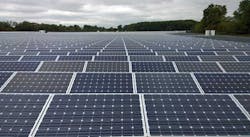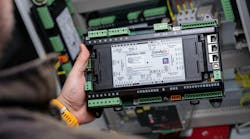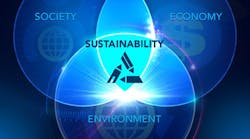Today we continue our Data Center Executive Roundtable, a quarterly feature showcasing the insights of thought leaders on the state of the data center industry, and where it is headed. In today’s discussion, our panel of experienced data center executives – Thomas Doherty of Aligned Data Centers, Matt Miszewaki of Digital Realty, Steve Hassell of Emerson Network Power, Jeff Klaus of Intel DCM, Joel Stone of RagingWire Data Centers and Jason Mendenhall of Switch – will examine how the emergence of hybrid cloud is impacting the world of multi-tenant data centers. The conversation is moderated by Rich Miller, the founder and editor of Data Center Frontier.
Data Center Frontier: A growing number of data center providers are embracing renewable energy. Is it becoming easier to procure renewables at a scale and price that makes sense for data centers? Which approaches hold the most promise?
MATT MISZEWSKI, Digital Realty
Matt Miszewski: Two interesting trends are coming together for energy and data centers. First, corporate buyers (including Digital Realty, Google, Facebook, Amazon, Apple, Equinix and others) contracted for almost 3.5 GW of new renewable energy power purchase agreement capacity in 2015. That was more than 50% of the overall PPA market in 2015 – for the first time it was more than what traditional utilities procured in a year. And earlier this month researchers released a report on total energy use by US data centers, updating prior research dating back to 2007. The findings indicate that data center’s explosive energy use has begun to plateau (contradicting earlier projections) at around 70 billion kWh, with load growth of only 4 percent from 2010 to 2014. Taken together, this indicates a sea-change in how seriously the data center industry is focusing on managing its carbon footprint by becoming more efficient and by procuring non-polluting energy to power data centers.
Earlier this month, we announced a landmark renewable energy agreement as a part of Digital Realty’s ongoing efforts to drive sustainable energy consumption in its data centers. This long-term agreement with E.ON Climate and Renewables North America, LLC to purchase approximately 400,000 megawatt-hours of wind power annually will offset 100 percent of the energy usage of Digital Realty’s U.S. Colocation and Connectivity business, reducing our data center carbon footprint by approximately 275,000 metric tons per year.
The environmental benefits from this agreement have an impact comparable to taking 58,000 cars off the road each year or offsetting the carbon emissions of 29,000 U.S. homes per year. This agreement to purchase wind power expands on our existing programs such as our Clean Start Program, that has procured 100,000 megawatt-hours of renewable energy credits for new customers, and our European power procurement program that supplies our data centers in the EMEA region with 100% renewable energy.
As CIOs and IT leaders transition their businesses to the cloud, even more resources are required to establish and maintain these facilities. By capitalizing on green power as a unique way to deliver highly efficient and sustainable solutions that meet the needs of an increasingly connected world, Digital Realty is staying at the forefront of the data center industry.
We also recognize the importance of addressing the growing demand among our customers for renewably powered data centers and we are deeply committed to sustainable and environmentally responsible business practices.
STEVE HASSELL, Emerson Network Power
Steve Hassell: The scale of the industry is helping to advance the availability of renewables. The data center industry is likely the single largest non-government mandated driver for new renewable energy coming on line.
I can’t think of another industry that demands a very high percentage of renewable energy on the local grid when selecting a site for their next large deployment. Utilities that can meet this demand have an advantage in attracting new development.
There are several factors contributing to this push to source and/or deploy renewable energy. These include the social and boardroom impact of environmental activism, shareholder proxy battles for corporate action and reporting on CO2 and related causes, and the increasing importance of corporate sustainability reporting.
In addition, renewables often make good business sense through the improved cost models of many renewables; long-term purchasing agreements with known, future-proof energy pricing; and the perception of greater reliability compared to the traditional grid.
We expect to see this trend continue to grow with some of the larger data center operators becoming local utilities or functioning as grid-connect assets for grid stability, energy storage, and energy services.
JOEL STONE, RagingWire
Joel Stone: Increasing the usage of renewable energy in data centers requires a close partnership between the data center provider and the energy utility.
Our experience is that the technical challenges of producing and distributing renewable energy are well understood and attracting innovation. The next step on the journey to renewables will be more about contracts, regulation, and pricing.
For example, we work closely with Dominion Virginia Power to support our Ashburn Virginia data center campus. Dominion has been an excellent partner to the data center industry, providing electricity that is reliable, cost effective, and available. Dominion is now partnering with the data center industry to create new “green tariffs” and power purchase agreements that can enable data center companies to target the usage of renewable energy as part of their overall draw and retain competitive pricing. Under these new agreements, Dominion provides the energy management services and administration. The data center company makes a commitment to renewables through specific green energy projects such as wind and solar.
JASON MENDENHALL, Switch SUPERNAPS
Jason Mendenhall: Moving forward, “green washing” will not be a sustainable approach for data center providers. Providers who are predominantly real estate developers will lose out to the increasingly sophisticated buyer that truly understands the energy market. Furthermore, buyers want to ensure that their technology footprint is driven by a true renewable energy driven data center.
This is not to say that the data center requires a renewable energy source attached to the building. The successful data center provider has the scale to engage in active partnerships and commit to fund new renewable energy projects. However, this requires scale, sophistication and an unwavering commitment from senior management to make it part of company culture, business philosophy and pledge to operate sustainably.
For instance, Switch is building a 180 MW solar project, which will enable its Nevada SUPERNAP data centers to operate on 100 percent clean and renewable energy. Additionally, when Switch chose to expand into Grand Rapids, Michigan, one of its major site selection criteria was access to renewable energy sources, which is why since day one it’s operating the new West Michigan SUPERNAP data center campus on 100 percent renewable energy.
Soon enough, data centers powered by renewable energy will not just be a nice to have, but will be a requirement for all enterprises. In fact, recent statistics indicate that we have will have 50 billion devices connected to the Internet by 2020, which translates to approximately 200 GW required just to support the devices. The industry must take a leadership role in driving true renewable energy solutions for their customers.
JEFF KLAUS, Intel
Jeff Klaus: In short, yes. Intel has been a leader embracing renewable energy for years. In fact, last year the US EPA’s Green Power Partnership recognized Intel for the seventh year in a row as the largest voluntary purchaser of green power in the US, purchasing enough renewable energy certificates to meet 100% of its US electricity use for the year.
This amounts to approximately 3.1 billion kWh. Some companies and COUNTRIES make this part of their culture or strategy and based on location climate could determine if wind, solar or other forms are appropriate for them specifically. It’s much easier to procure as illustrated by a data point. For example, I understand that every 2 minutes a new solar energy system is installed in the united states last year – and that is significant progress.
THOMAS DOHERTY, Aligned Data Centers
Thomas Doherty: With all of our utility agreements, we have provisions to offer renewable energy with assignable renewable energy credits (REC’s). As our customers look for ways to meet their corporate environmental stewardship, we are pleased to support these commitments. In addition, reducing energy consumption through the most efficient electrical and mechanical systems in the industry enables our customers to reduce their carbon impact. Edison Award winning, patented Inertech systems, a subsidiary of Aligned Energy, enables Aligned Data Centers to offer a guaranteed PUE of less than 1.15.
NEXT: Rating the data center industry’s progress on energy efficiency.
Keep pace with the fact-moving world of data centers and cloud computing by following us on Twitter and Facebook, connecting with me on LinkedIn, and signing up for our weekly newspaper using the form below:
About the Author



